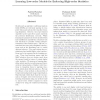107
click to vote
JMLR
2012
12 years 9 months ago
2012
Models such as pairwise conditional random fields (CRFs) are extremely popular in computer vision and various other machine learning disciplines. However, they have limited expre...
JMLR
2012
12 years 9 months ago
2012
Often when modeling structured domains, it is desirable to leverage information that is not naturally expressed as simply a label. Examples include knowledge about the evaluation ...
EMNLP
2011
13 years 6 months ago
2011
Linear models have enjoyed great success in structured prediction in NLP. While a lot of progress has been made on efficient training with several loss functions, the problem of ...
ICASSP
2011
IEEE
13 years 10 months ago
2011
IEEE
Gradient boosting is a flexible machine learning technique that produces accurate predictions by combining many weak learners. In this work, we investigate its use in two applica...
JMLR
2010
14 years 1 months ago
2010
Structured prediction tasks pose a fundamental trade-off between the need for model complexity to increase predictive power and the limited computational resources for inference i...
JMLR
2010
14 years 1 months ago
2010
We consider regularized stochastic learning and online optimization problems, where the objective function is the sum of two convex terms: one is the loss function of the learning...
JMLR
2010
14 years 1 months ago
2010
In this paper, we investigate the problem of binary classification with a reject option in which one can withhold the decision of classifying an observation at a cost lower than t...
ACCV
2010
Springer
14 years 1 months ago
2010
Springer
Support Vector Regression (SVR) has been a long standing problem in machine learning, and gains its popularity on various computer vision tasks. In this paper, we propose a structu...
IR
2010
14 years 4 months ago
2010
Abstract Most ranking algorithms are based on the optimization of some loss functions, such as the pairwise loss. However, these loss functions are often different from the criter...
TIT
2002
14 years 6 months ago
2002
The problem of optimal sequential decision for individual sequences, relative to a class of competing o -line reference strategies, is studied for general loss functions with memo...

